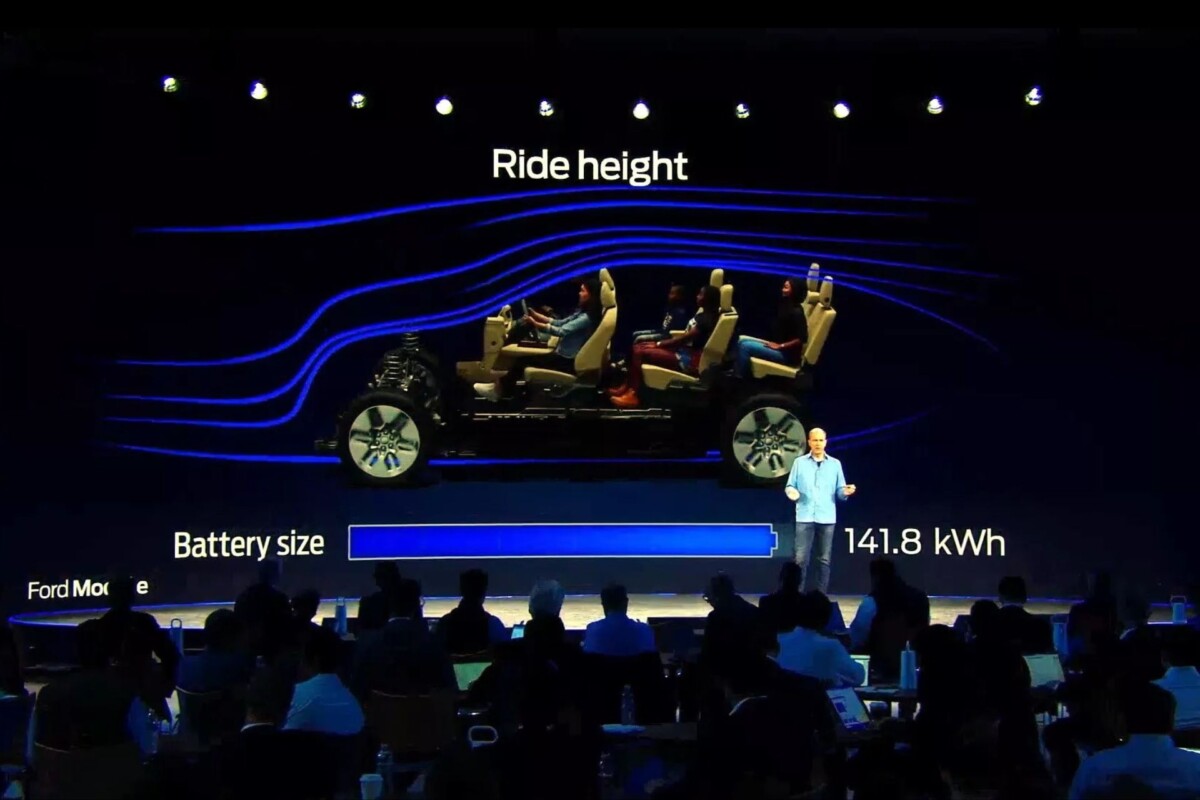A strong advocate of small batteries, Ford has found a way to limit the battery size of its future large electric SUV. And this without cutting back on autonomy, which is still a very important aspect for customers today.
Ford is determined to expand its electric range, while the brand announces that all its models will be available in a version without engine combustion from 2030 in Europe. The firm also plans to produce no less than 2 million zero-emission (exhaust) cars per year by 2026.
A newcomer
It is all the same already on the right track, while it has several electric models in its range. These include the Mustang Mach-E and the F-150 Lightning, as well as the new Explorer that we were able to discover in preview. We also think of the brand new e-Transit Courier unveiled a few days earlier. But that’s obviously not all.
Indeed, the American manufacturer also announced that a new model would be in preparation. This time it’s a large SUV, which should cap the range by taking inspiration from the current Expedition marketed with a combustion engine. For the moment, we still know very little about this newcomer, whose name has not been revealed.

However, the Dearborn firm gave some small information about it, especially with regard to its batteries. The manufacturer now favors LFP (lithium – iron – phosphate) technology, which has many advantages. Among them, a lower production cost than NMC (nickel – manganese – cobalt) chemistry as well as potentially faster charging. This makes it possible to compensate for the lower density, and therefore less autonomy for an equivalent size.
This technology, acclaimed by the Stellantis group and already present on the Mustang Mach-E will be used by Ford’s future SUV. The latter will not be just a simple electric version of the Expedition already marketed, as confirmed by Doug Field, product director of the brand, relayed by the site Green Car Report.
Generous autonomy
Indeed, in this case, it would have been necessary opt for a 150 kWh battery to achieve a highway range of 480 kilometers. However, we know that the manufacturer is firmly against this solution. Indeed, and as we have already explained in a previous article, packs that are too big have many disadvantages. Their high weight has an impact on consumption, and therefore on autonomy.
For his future seven-seater electric SUV, Ford is choosing a 100 kWh battery, which is lighter and less expensive. Autonomy should turn around 350 miles, which is equivalent to about 563 kilometers in the combined cycle. On the highway at a constant speed of 70 miles per hour, or about 113 km/h, the car should be able to travel 300 miles (or approximately 483 kilometers) according to the EPA cycle. But what is Ford’s recipe?
Doug Field sharing some new details on Ford EVs.
Says a 3-row family SUV is coming in 2025 with a 350-mile range. He liked it to an Expedition. pic.twitter.com/FixnHKIj2Y
— Michael Martinez (@MikeMartinez_AN) May 22, 2023
To achieve such great autonomy without installing a huge battery, the brand’s teams want turn this SUV into a “high-speed train”. For this, the height will be reduced (- 10 kWh) and the shape will be overall more aerodynamic (- 32 kWh) in order to reduce air resistance, which should save around 42 kWh according to information fromClean Automotive. Adjustments will also be made to the tyres, the weight and the engine of the vehicle to allow the capacity of the battery to be reduced by 8 kWh without losing autonomy.
If we do not yet know the maximum power that can be collected by the battery of the SUV, Ford explains that it will be possible to recover 240 kilometers of autonomy in just 10 minutes. Is an 800 volt architecture on the program? Nothing is to be excluded…
The interior is expected to be groundbreaking for a Ford car, with a screen that will run across the entire dashboard, as seen in the teaser image.

Expected for 2025, this newcomer to the range will see the light of day almost at the same time as the electric Puma, which will also have a small battery. The large seven-seater SUV should also offer an all-new infotainment system. It remains to be seen whether it will be marketed in Europe or not…
Want to join a community of enthusiasts? Our Discord welcomes you, it’s a place of mutual aid and passion around tech.
